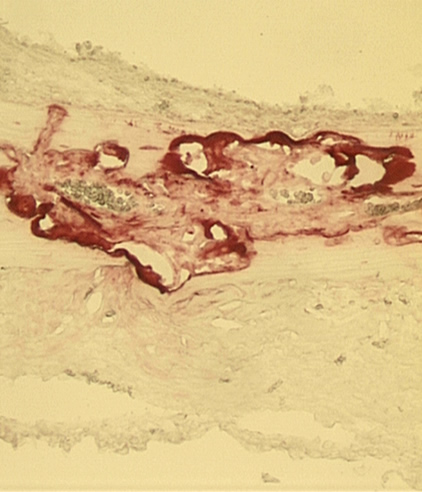
Investigators supported in part by the NIH’s National Institute of Arthritis and Musculoskeletal and Skin Diseases (NIAMS) have shown how a protein called RBP-J controls a pathway that promotes bone degradation, a common complication of rheumatoid arthritis. The study also revealed that decreased levels of RBP-J are linked to the disease and could partly underlie the associated bone loss. The findings, which appeared in the Journal of Clinical Investigation, suggest that targeting the RBP-J pathway could be an effective strategy for preserving bone in people with rheumatoid arthritis.
Rheumatoid arthritis is an autoimmune disorder in which the body’s immune system mistakenly attacks the joints, creating inflammation. This results in chronic pain and swelling in the joints. Organs such as the bones, heart and lungs may be affected, as well. There is no cure for rheumatoid arthritis, but medicines that dampen the immune response are used to help ease the symptoms.
Although inflammation is known to play a part in bone erosion by increasing the production of osteoclasts, a type of cell that breaks down bone, scientists have been uncertain exactly how inflammatory molecules trigger the development of these cells.
To gain a better understanding of the process, researchers led by Baohong Zhao, Ph.D., assistant professor at the Weill Medical College of Cornell University and assistant scientist at the Hospital for Special Surgery, focused on a protein called RBP-J. Earlier work in Dr. Zhao’s lab had shown that RBP-J was involved in suppressing the formation of osteoclasts and restraining bone erosion. Osteoclast maturation and activity are regulated by a complicated network of signaling pathways that fine-tune the rate and degree of bone degradation. Dr. Zhao’s team wondered if RBP-J controlled this process by interacting with a pathway named RANK, another pathway named ITAM, or both.
While the earlier studies had indicated that both the RANK and ITAM pathways must be active in osteoclast precursor cells before osteoclasts develop, some evidence suggested that the ITAM pathway was not always essential. In the current study, Dr. Zhao’s team discovered that RBP-J controls whether the ITAM pathway needs to be involved. Cells from mice lacking both RBP-J and certain ITAM molecules could produce osteoclasts when investigators activated the RANK pathway. In contrast, when the precursor cells contained RBP-J, RANK stimulation did not promote osteoclast formation unless the cells also could engage the ITAM pathway.
This suggests that RBP-J functions like a block in the ITAM pathway, and much like releasing the brake sets a car on a hill in motion, removal of RBP-J enables the ITAM pathway to proceed.
To mimic the conditions in rheumatoid arthritis, the researchers next examined the effect of an important inflammatory molecule, TNF?, on bones in mice. TNF? had previously been shown to trigger bone erosion associated with rheumatoid arthritis.
When they injected TNF? into the lining of the mice’s bones, they saw more osteoclasts and greater bone erosion in RBP-J-deficient mice than in controls. These findings suggested that elevated levels of inflammatory molecules such as TNF?, a hallmark of rheumatoid arthritis, when coupled with RBP-J deficiency, could aggravate the bone destruction that can occur with the disease.
To assess if RBP-J deficiency is associated with rheumatoid arthritis, the investigators next compared RBP-J levels in osteoclast precursor cells from rheumatoid arthritis patients and healthy individuals. They saw significantly less RBP-J in the patients’ cells than in controls. This finding, together with genetic studies that linked certain variants of RBP-J to rheumatoid arthritis susceptibility, suggests that RBP-J could be a key factor in the disease.
"We’ve shown that in rheumatoid arthritis, decreased levels of RBP-J set the stage for the bone destruction experienced by people with the disease," said Dr. Zhao. "In the future, by targeting RBP-J or other components of the ITAM pathway, we may be able to preserve bone health in people with rheumatoid arthritis or other inflammatory bone diseases."
This work was supported by grants from the NIH, including NIAMS grant R00-AR062047 to Baohong Zhao.
# # #
RBP-J imposes a requirement for ITAM-mediated costimulation of osteoclastogenesis. Li S, Miller CH, Giannopoulou E, Hu X, Ivashkiv LB, Zhao B. J Clin Invest. 2014 Nov;124(11):5057-73. doi: 10.1172/JCI71882. Epub 2014 Oct 20. PMID: 25329696
The mission of the NIAMS, a part of the U.S. Department of Health and Human Services' National Institutes of Health, is to support research into the causes, treatment and prevention of arthritis and musculoskeletal and skin diseases; the training of basic and clinical scientists to carry out this research; and the dissemination of information on research progress in these diseases. For more information about the NIAMS, call the information clearinghouse at (301) 495-4484 or (877) 22-NIAMS (free call) or visit the NIAMS website at https://www.niams.nih.gov.
